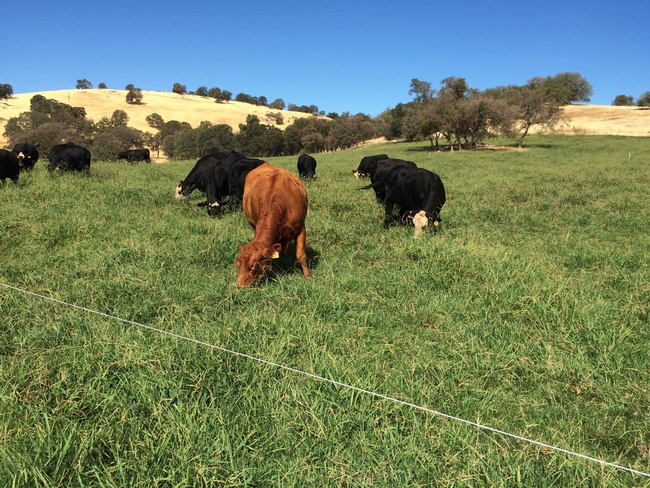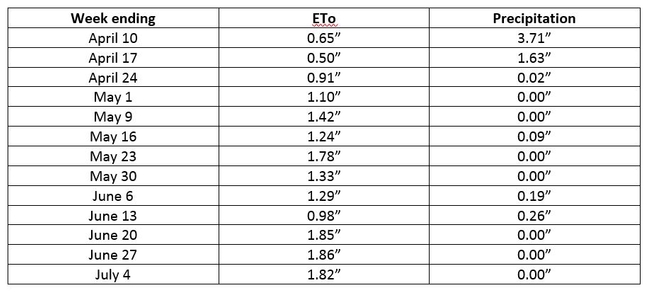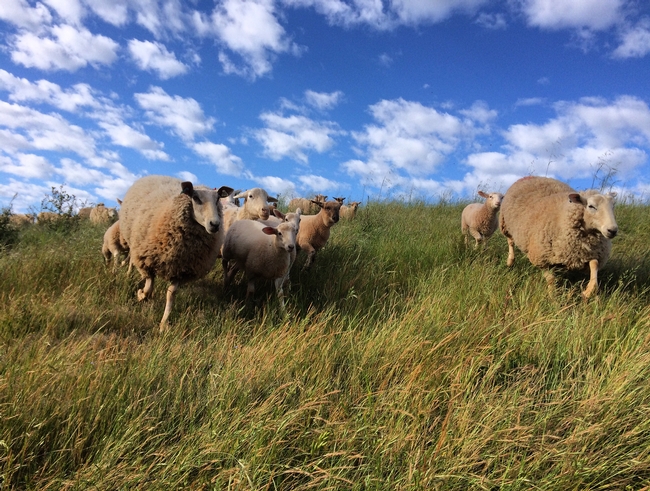
For me, irrigating pasture is a unique blend of art and science. I'll get to some of the science in a moment. Moving water across a field - whether by flood irrigation, hand-pipe sprinklers or a movable pod system - is truly an art. The best irrigators I've known have a sixth sense about when and how to move water to grow grass. I've known some irrigators to whom the laws of gravity did not apparently apply - I'd swear they could make water flow uphill!
These irrigators have an intuitive sense of the science behind irrigation. They understand that water demand (in the form of transpiration by plants and evaporation from the soil - together these are called evapotranspiration or ETo) changes based on climatic conditions and time of year. They understand that well-managed soils hold on to moisture. Canopy cover, soil structure and organic matter all influence a pasture's water holding capacity.
Fortunately, for those of us who lack this intuitive sense of when and how much to irrigate, there are some easily accessible tools for measuring factors like ETo and soil moisture. A shovel, perhaps, is the pasture irrigator's most important tool - with a shovel we can see what's going on below the surface. The Natural Resources Conservation Service has a useful photo guide to estimating soil moisture by feel - all you need to do is dig into the root zone and grab a handful of soil! Soil moisture sensors can also provide a look at what's happening below the soil surface - these sensors can provide a more accurate estimate of how much soil moisture is available in the root zone of our pasture plants.
If measuring soil moisture tells us about the supply side of the irrigation equation, ETo tells us about demand. Evapotranspiration is typically expressed in the inches (or volume) of water used by a planted area within a certain timeframe. ETo is dependent on the physiology and structure of plants, as well as on climatic factors like sunlight, air temperature, relative humidity and wind speed. Site-specific reference ETo data is provided by the Department of Water Resources California Irrigation Management Information System (CIMIS) website. This data is generated from weather stations throughout the state - including stations in Auburn and at the Sierra Foothill Research and Extension Center in Browns Valley. Reference ETo estimates the water used by cool-season pasture grasses and provides a great starting point to determining how much water our pastures need.
To give you some sense of how ETo changes over the course of the irrigation season, here's a weekly summary of ETo and precipitation for Auburn since the start of our irrigation season in mid-April. Keep in mind, when ETo (demand) exceeds the precipitation (natural supply) in a given time frame, we have to make up that deficit with irrigation (if we want our pastures to keep growing). I find it especially interesting to note that ETo nearly doubled from June 13 to June 20 - I suspect this sudden change in conditions stressed our pasture plants.
Much of the research into irrigated pasture in northern California was conducted many years ago. Given the evolving nature of water use and agricultural production in Northern California, new science-based information about water use efficiency, forage production, and the environmental benefits provided by irrigated pasture is critical. To begin to answer some of these key questions, we are initiating a 3-year cross-sectional survey of irrigated pasture management practices in partnership with Dr. Leslie Roche and the UC Rangelands program at UC Davis. We'll be using rapid assessment tools to measure forage productivity, diversity and soil fertility across a range of grazing, water and nutrient management intensities. We'll also be developing workshops and field days designed to help ranchers understand and use our findings. Stay tuned for details!
In the meantime, I encourage you to check out these resources on irrigated pasture:
UC Rangelands Irrigated Pasture Management Page
Irrigated Pasture Nitrogen Management and Planning
California Irrigation Management Information System
Estimating Soil Moisture by Feel and Appearance
